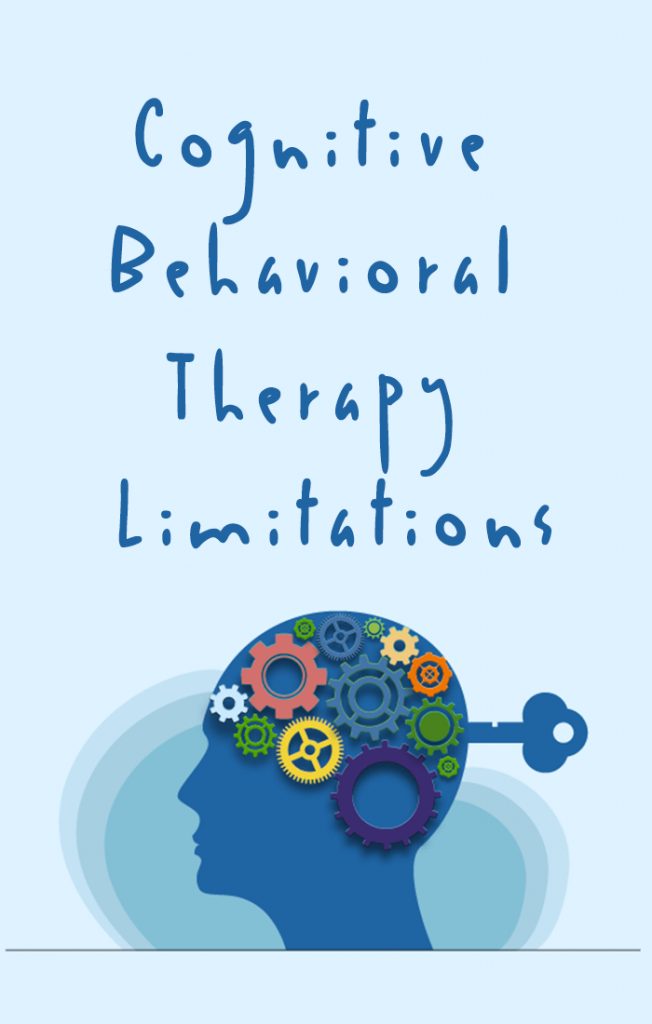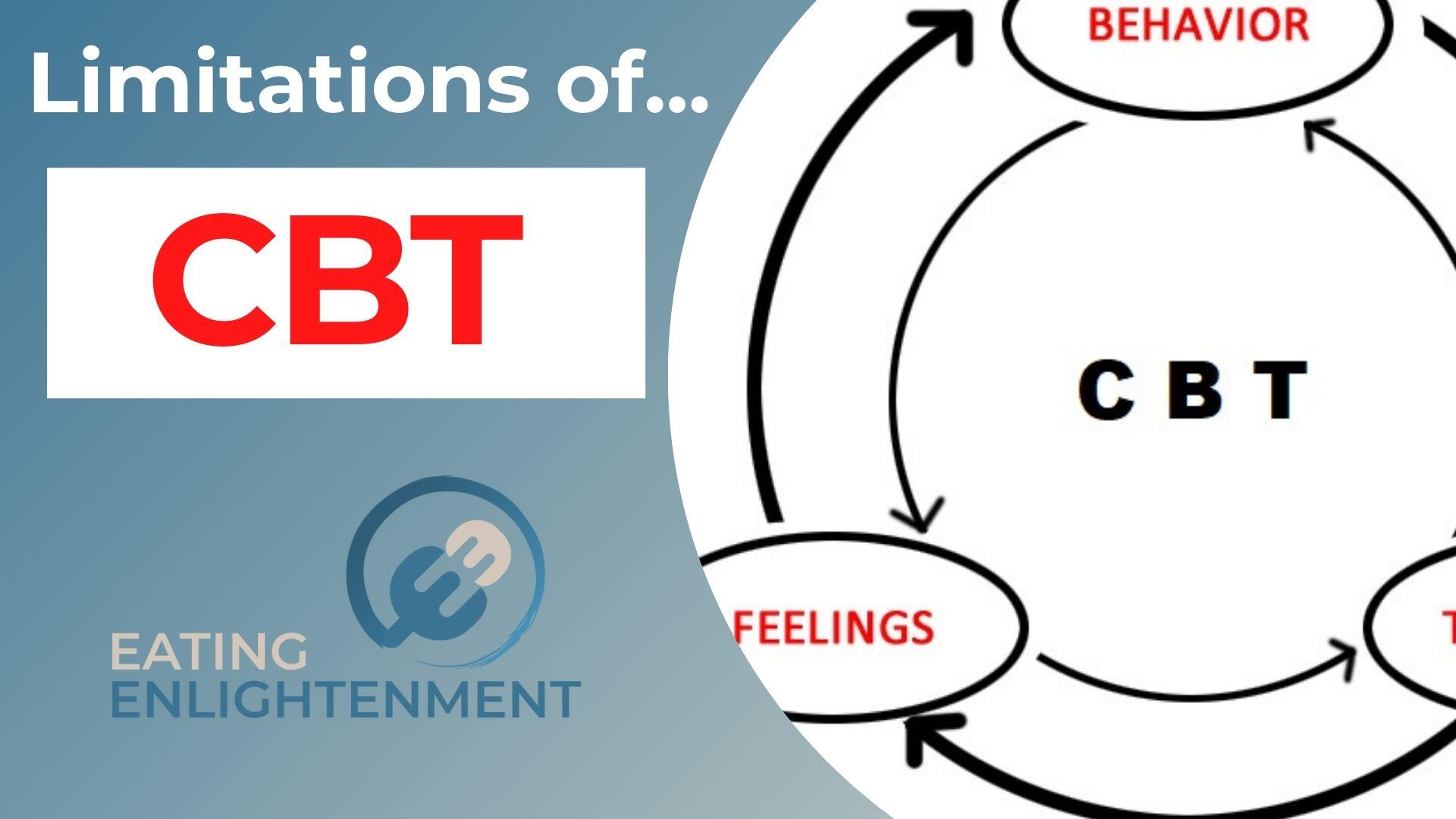Wondering about Cognitive Behavioral Therapy limitations?
Cognitive Behavioral Therapy (CBT) is a form of cognitive therapy that has been around for over 50 years. It is used to treat anxiety, depression and other mental disorders.
At Eating Enlightenment, our first service can address over 90% of binge eating disorder problems and is based on CBT.
CBT can also be used in psychotherapy, anxiety, depression and addiction recovery. This type of therapy is popular because it’s one of the most effective types of treatment available today for a variety of psychological disorders.
Of course I’m a huge fan of CBT because it works so well for eating struggles.
But I definitely admit it’s not the total solution for bingeing, or for any other mental health struggles.
So I think it’s good to discuss the limitations. What are some criticisms?
First, let’s give a brief overview of CBT for people who’ve never heard of the term and then we’ll dive in.
What is Cognitive Behavioral Therapy (CBT)?
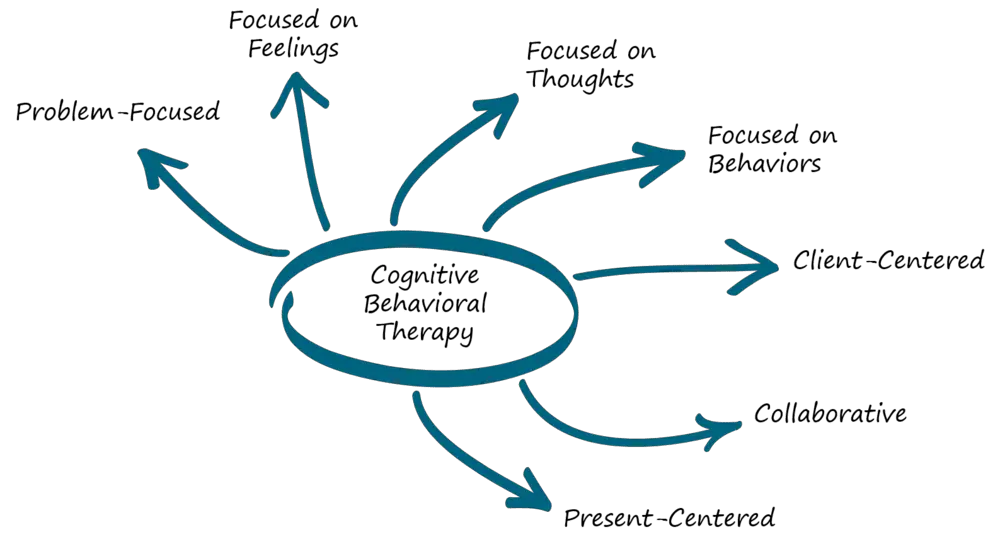
CBT is a type of psychotherapy that helps you identify and manage cognitive distortions (such as twisted or irrational thinking).
Let’s examine these two words, Cognitive and Behavioral:
- The cognitive part focuses on the thinking patterns associated with your fears.
- The behavioral part involves therapy strategies that focus on changing your behavior to improve how you feel.
What are thinking patterns in relationship to food struggles? Well, for example, that little voice that whispers to you to have “one more bite”!
When you start to explore these distortions using CBT, you’ll see WHY you think these thoughts.
For example, you’ll see that subconsciously you believe food keeps you safe. So of course you’ll eat food when feeling unsafe!
Obviously this doesn’t make sense at first glance. Eating food will keep you safe? How will a burger keep you safe?
But cognitive distortions, irrational beliefs, and negative thoughts are not rational.
That’s why we examine them – and as we get more used to doing so, these false thoughts tend to ease.
You can also study your reactions, triggers, and cues using CBT methods to great effect!
What about the behavioral part of CBT?
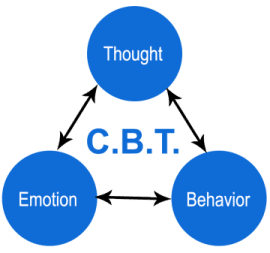
Ok, so part of CBT is working with the stuff in your mind and heart. Thoughts, emotions, beliefs, etc.
The other side of the coin is actual behavior.
In CBT, what I love is that when you study your behavior, you naturally gain insight into the stuff in your mind and heart.
For example, a beginner CBT technique which I use with private clients all the time is self-monitoring.
Self-monitoring for binge eaters is where you try to write down WHY you are about to binge, before you actually engage in eating.
Sounds strange right? Write down why I’m about to compulsively eat?
Yes! That’s precisely the point!
This is how you combine both behavioral correction and insight into your psychology! By journaling like this, you can look back over time and – perhaps for the first time – begin to see your trends and triggers. You gain a much more comprehensive cognitive model which helps you change your relationship to food.
When you journal before you eat, you’ll soon significantly cut compulsive eating. You’ll also gain psychological wisdom into WHY you want to overeat in the first place! These insights can unlock your growth mindset.
And it’s very important you do this work yourself!
Because while I can “tell” you that one reason for bingeing is because food helps the subconscious part of your brain feel safe…
Unless you do “the work” and obtain the knowledge yourself, then this knowledge won’t change your behaviors one bit!
Alright, with my love of CBT professed, let’s dive now into some Cognitive Behavioral Therapy limitations!
What are the limitations of Cognitive Behavior Therapy?
Because I am biased a fan of Cognitive Behavioral Therapy, I wanted to provide another resource to for you to consider the limitations of CBT.
Hope this image helps, and then below you can read my thoughts on CBT’s shortcomings.
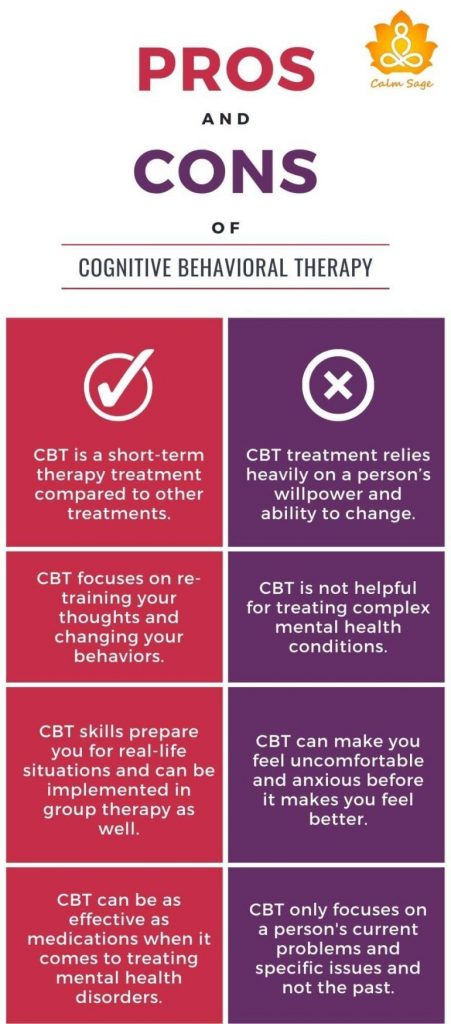
1 – You need to commit
To get the most out of CBT, you must be dedicated to the procedure. A therapist may assist and advise you, but he or she cannot cure your problems without your collaboration.
How much time and effort is required?
For Binge Eating Disorder, I would say the expectation is attempting to journal every time before you eat for 1 month. I’m not talking about tons of journaling before you eat, but at least 1 minute each time.
So that’s at least 3-5x each day where you take out the journal before you eat, pause, consider, and write about your experiences.
Around 10-20 minutes per day.
Of course you won’t be perfect, and that’s ok. We need to have compassion around journaling and not to beat ourselves up if we aren’t perfect.
We also need to have a Growth Mindset where we view journaling itself as a skill. Because when you first start to journal you won’t immediately stop 100% of compulsions. But if you learn from your compulsions, then you can decrease them.
We need to set the expectation upfront that self-monitoring before you eat is very important.
Is it worth it?
It’s up to you to decide whether CBT could provide enough benefits.
You might want cognitive behavioral therapy benefits such as:
- improved self-esteem
- decreased anxiety
- less depression
- fewer binges and compulsions
If you’re uncertain about the benefits of CBT then please view our results page. There we have a whole host of testimonials and case studies you can view.
But of course, all this depends on how willing you are to put in some work!
2 – Takes up time
Attending regular CBT sessions and carrying out any extra work between sessions (like completing worksheets) can take up a lot of your time.
As we mentioned earlier, to get the most out of CBT you must be willing to put in the effort.
This may not be ideal if you are already struggling with your time commitments.
Again, how much time is required?
See above for an answer! 🙂
But again, it’s up to you whether or not this extra work is worth it.
Remember that cognitive distortions can lead to debilitating mental health struggles!
So trying cognitive behavioral therapy for a limited amount of time could be very beneficial.
In fact, one idea if you are on the verge of considering CBT, is to spend a few dollars on some CBT worksheets and try them out.
If they resonate it’ll be well worth the investment, and if not, then you saved yourself from investing in a therapy that doesn’t resonate!
3 – It’s Analytical
Here is one of the blank food journal templates we ask clients to print out.
Notice all the columns?
CBT is inherently an analytical approach where you record, measure, and analyze your behavior.
In my opinion, the analytical approach is CBT’s greatest strength and greatest weakness.
The strength of this analytical approach is that, in the beginning, this is perfect for overeaters and people who think too much.
Overeaters and overthinkers really enjoy an analytical approach!
Something that’s very simple, straightforward and helps them see immediate reductions in compulsions.
But, you certainly don’t want to journal your whole life! That would be terrible if you had to record before you eat for the rest of your life!
Talk about Obsessive Compulsive Disorder if you had to journal EVERY time before you ate for the REST of your life? That’s CRAZY!!!
No, that’s NOT what we do here. We recommend journaling as one of a few useful and practical strategies that you learn, integrate, and ultimately let go of.
Like training wheels on a bike!
However, in many ways, CBT can become a crutch. I’ve had clients who simply didn’t want to give up journaling because it helped them reduce compulsions to such a degree that they didn’t want to stop.
What about social and everyday life? Are you really going to journal before eating dinner with your friends and family?
I mean, sure, it’s fine for a relatively short period like one or two months. But your whole life?
The self-monitoring and journaling aspect of CBT can become a crutch. Something you need. It works, like training wheels on a bike to keep you upright, but you ultimately have to let go of the journal.
4 – Initial Anxiety
CBT can lead you to be more aware of feelings like anxiety and dread, which may be uncomfortable at first.
Oftentimes CBT and writing make you become more aware of the emotional reasons why you eat.
Of course, becoming aware of the emotional reasons why you compulsively eat is key …
This means that you won’t be using food as much to dull and avoid those feelings!
But there can definitely be some initial anxiety with journaling.
I’ve heard clients many times wonder:
- if they were doing it right
- how much to write
- what happened if they continued to eat after journaling, etc.
Of course, when learning any new skill, you’re going to have similar thoughts.
Even sticking with the bicycle analogy, if you’re new to bike riding you’ll be anxious about the tires, the road, the weather, etc.
But once you practice a bit then you’ll be fine 🙂
Same with journaling!
The key is really thinking about whether you want to do the work to be free. If you are properly motivated, then you’ll commit and see the results.
Please note too …CBT is great for anxiety overall!
5 – Does Not Address Causes
Critics argue CBT does not address the causes of mental health problems, such as a bad childhood.
This is a very important criticism. What about dealing with the cause of these negative behaviors and thoughts?
In Cognitive Behavioral Therapy, you do not deal with the causes of these behaviors.
You only focus on what’s happening now and how to change it based on certain principles.
CBT is designed for a singular purpose: reduce symptoms as quickly as possible so that you can feel better fast!
This doesn’t mean CBT does not help people who have had bad childhoods or experienced trauma in their lives…
It’s just in this first step of self-monitoring we are totally focused on the compulsions themselves.
From past experience working with clients, dealing with childhood issues is important.
But if a client is still binging then we need to decrease the binges first before doing the hard work on the childhood patterns.
However, like I said above, this first step sometimes is enough to get rid of binges perhaps 90-100% of the time, but even then it may not get rid of all binges.
For example, someone might decrease their emotional eating from 7x per week but they may still binge or compulsively eat 1x per week.
This is why at Eating Enlightenment the self-monitoring, journaling and CBT part is our first service. It takes about 2 months, give or take.
After this stage many clients are ready to stop. They feel:
- Safe around food again
- Back in control
- Understand their compulsions
- How to avoid compulsions without restriction
For many people, even if they are still emotionally eating, they are ready to stop treatment at this stage! And that’s great!
But, in my opinion, going deeper into your subconscious is a great idea too. And Cognitive Behavioral Therapy is NOT suited for this.
That’s why we at Eating Enlightenment offer additional services when CBT isn’t enough. These services are more psycho-dynamic in nature and help people explore their past in order to understand the roots of their emotional eating.
In this stage we use a variety of techniques like:
- role playing
- visualization
- dialoging
- “movie-making”
For more on this approach, see ___
Overall, Cognitive Behavioural Therapy is great for symptom relief but it does have limitations. It’s important to be aware of these criticisms before starting treatment!
6 – Does Not Talk About Cultural Systems Or Relationships
CBT focuses on the client’s ability to modify themselves (their thoughts, feelings, and behaviors), rather than addressing underlying issues or problems in systems or families that frequently have a significant influence on an individual’s health and wellness.
For example, what about size discrimination?
Even though body weight and health are not necessarily correlated (you can be bigger and have perfectly fine health metrics), that doesn’t change the fact that when you buy clothes it might be hard to find sizes that fit your physique.
And what about those annoying relatives of yours who comment on your body? Those comments hurt!
But CBT focuses on individuals and their eating, that’s it. It focuses on modifying the individual to resolve their presenting mental health conditions.
CBT does not address wider social problems like annoying relatives.
While relationships are important, they are not the focus of CBT treatment. This is an important thing for people to know before beginning cognitive therapy!
And if CBT doesn’t even really talk about annoying family members, it definitely doesn’t talk about systemic or cultural issues that might be impacting a person’s health and wellness!
Issues of complex mental health involving multiple entities is NOT what CBT is about.
Overall, CBT is very grounded in Western Individualism, and not Eastern Collectivism. (In contrast, mindfulness, a traditionally eastern value, is cherished here at Eating Enlightenment.)
Thanks for reading about my thoughts on some cognitive behavioral therapy limitations! Stay tuned for more posts about Cognitive Behavior Therapy! 🙂
